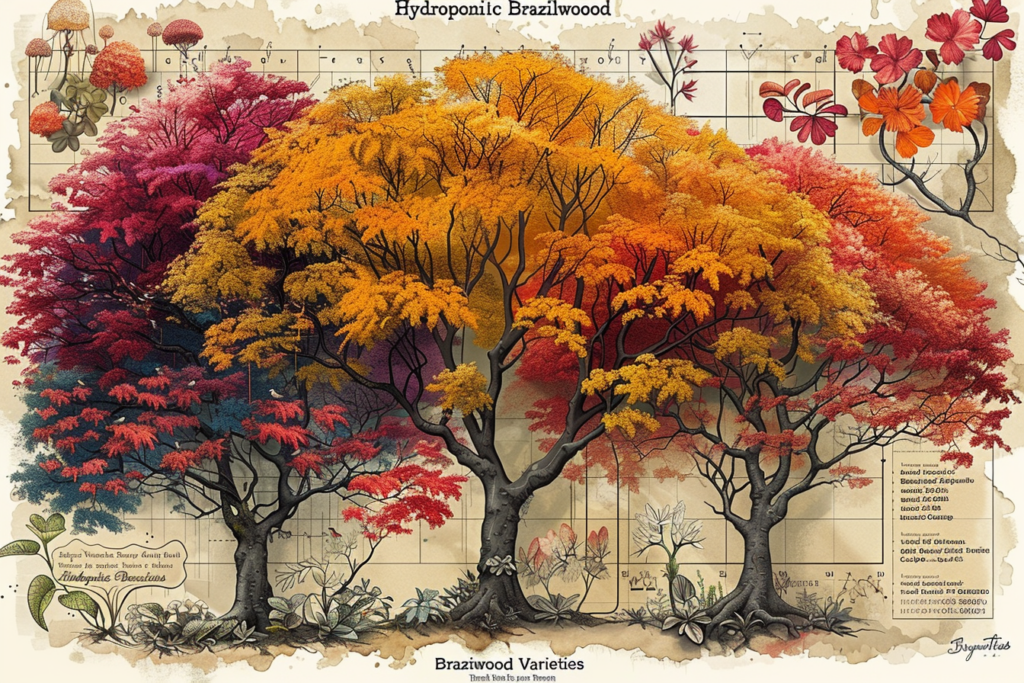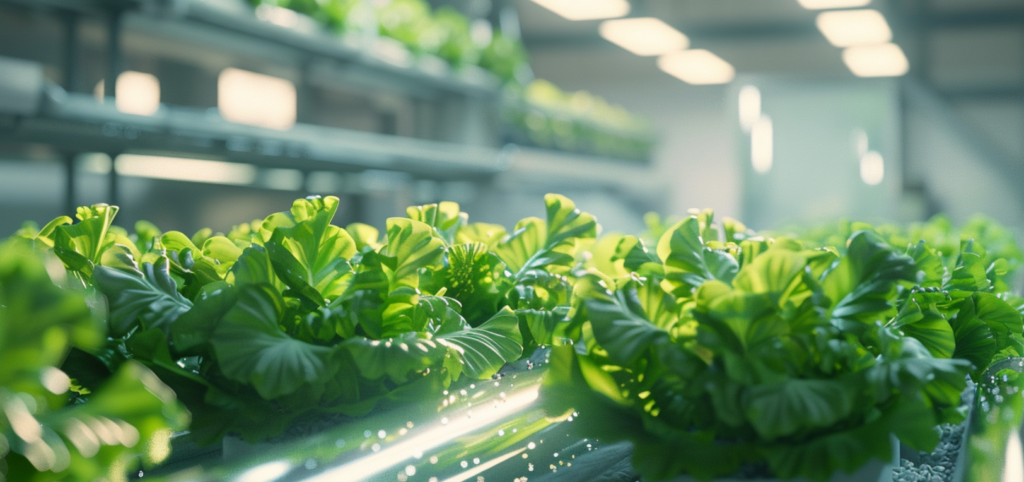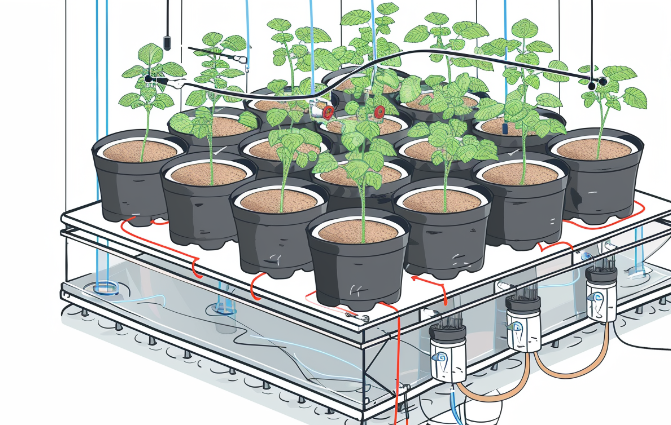Introduction
Hydroponic gardening has been gaining immense popularity in recent years, and one plant that has captured the attention of enthusiasts is the brazilwood. As a passionate gardener, I have witnessed the growing interest in cultivating these vibrant and versatile plants hydroponically.
Brazilwood, known for its rich red hue and unique properties, offers a multitude of benefits when grown in a controlled hydroponic environment.
One of the primary advantages of hydroponic cultivation is the ability to optimize growing conditions, ensuring faster growth rates and higher yields. Additionally, hydroponic systems allow for efficient use of water and nutrients, making them an environmentally friendly and sustainable choice.
As we delve into the world of brazilwood hydroponic plants, I will guide you through the essential steps to thrive in this exciting endeavor, from selecting the right variety to harvesting and post-harvest care.
Overview of brazilwood hydroponic plants and their growing popularity
Brazilwood, scientifically known as Caesalpinia echinata, is a remarkable tree species native to the Atlantic Forest region of Brazil. Its vibrant red heartwood has been prized for centuries, not only for its natural dye properties but also for its medicinal and ornamental uses. In recent years, the cultivation of brazilwood has gained significant traction, particularly in the realm of hydroponic gardening. The growing popularity of brazilwood hydroponic plants can be attributed to several factors.
Firstly, the controlled environment of hydroponic systems allows for precise management of growing conditions, ensuring optimal growth and yield. Secondly, hydroponic cultivation eliminates the need for soil, reducing the risk of soil-borne diseases and pests.
Additionally, the efficient use of water and nutrients in hydroponic systems aligns with sustainable and eco-friendly practices, appealing to environmentally conscious gardeners.
Furthermore, the versatility of brazilwood has contributed to its rising demand. Its striking red hue makes it a sought-after choice for natural dyes, while its medicinal properties have led to its use in traditional remedies. Brazilwood is also highly valued in the woodworking industry for its unique grain patterns and durability, making it a prized material for furniture, musical instruments, and decorative objects. As awareness of the benefits of hydroponic gardening continues to grow, the popularity of brazilwood hydroponic plants is expected to soar.
With its captivating beauty, versatility, and sustainable cultivation methods, brazilwood is poised to become a staple in the world of hydroponic gardening, captivating enthusiasts and professionals alike.
Benefits of cultivating brazilwood hydroponically
Cultivating brazilwood hydroponically offers a myriad of benefits that make it an attractive choice for gardeners and enthusiasts alike.
One of the primary advantages is the ability to control the growing environment precisely, ensuring optimal conditions for plant growth and development. By regulating factors such as nutrient levels, pH, temperature, and light exposure, hydroponic systems allow for maximized yields and accelerated growth rates. Another significant benefit of hydroponic cultivation is the efficient use of resources. Unlike traditional soil-based gardening, hydroponic systems require significantly less water and nutrients, making them an environmentally friendly and sustainable option. This not only reduces the ecological footprint but also results in cost savings for the grower.
Furthermore, hydroponic systems eliminate the risk of soil-borne pests and diseases, reducing the need for pesticides and promoting a healthier growing environment. This is particularly advantageous for brazilwood, as it is a valuable and sought-after plant, and maintaining its quality is crucial.
Additionally, hydroponic cultivation allows for year-round production, as the controlled environment is not subject to seasonal variations. This ensures a consistent supply of brazilwood, meeting the demands of various industries that rely on its unique properties.
Finally, the compact nature of hydroponic systems makes them suitable for urban and small-space gardening, enabling individuals with limited outdoor space to cultivate brazilwood successfully. This accessibility has contributed to the growing popularity of hydroponic gardening and the increased interest in cultivating unique and valuable plants like brazilwood.
Step 1: Choose the Right Brazilwood Variety
When embarking on the journey of cultivating brazilwood hydroponically, selecting the right variety is crucial. Different varieties exhibit varying characteristics in terms of growth rate, color intensity, and hardiness. For instance, the Pernambuco variety is renowned for its deep, rich red hue, while the Bahia variety is known for its faster growth rate. Additionally, some varieties may be better suited for specific applications, such as dye production or woodworking. To make an informed decision, I carefully consider factors like the intended use, available space, and desired growth rate. Consulting with experienced growers or reputable nurseries can also provide valuable insights into the unique traits and requirements of each variety, ensuring a successful hydroponic cultivation experience.
Different varieties of brazilwood suitable for hydroponic cultivation
Brazilwood, with its diverse range of varieties, offers numerous options for hydroponic cultivation.

Among the most popular and suitable varieties are:
1. Pernambuco:
Renowned for its deep, vibrant red hue, the Pernambuco variety is highly prized for its natural dye properties. Its heartwood is rich in brazilin, the compound responsible for the intense color. This variety is a favorite among artisans and woodworkers seeking a vibrant, long-lasting dye.
2. Bahia:
The Bahia variety is known for its rapid growth rate, making it an excellent choice for those seeking a quicker turnaround in their hydroponic cultivation. While its color may not be as intense as the Pernambuco, it still produces a beautiful reddish-brown hue suitable for various applications.
3. Pará:
Originating from the northern region of Brazil, the Pará variety is valued for its hardiness and resistance to pests and diseases. Its heartwood exhibits a slightly lighter red shade compared to other varieties, but it is highly sought after for its durability in woodworking projects.
4. Amazonas:
As the name suggests, this variety hails from the Amazon region and is well-adapted to warm, humid conditions. Its heartwood boasts a rich, deep red color, making it a popular choice for dye production and decorative purposes.
5. Hybrid varieties:
In recent years, hybridization efforts have led to the development of new brazilwood varieties that combine desirable traits from different parent plants. These hybrids may offer improved growth rates, color intensity, or disease resistance, catering to the specific needs of hydroponic growers. When selecting a brazilwood variety for hydroponic cultivation, it is essential to consider factors such as the intended use, desired color intensity, growth rate requirements, and environmental conditions.
Consulting with experienced growers or nurseries can provide valuable insights into the unique characteristics and suitability of each variety for your specific hydroponic setup.
Factors to consider when selecting a variety (growth rate, color, hardiness)
When selecting a brazilwood variety for hydroponic cultivation, several key factors must be taken into consideration to ensure optimal growth and desired outcomes.
Growth rate is a crucial aspect, as some varieties may exhibit faster or slower development compared to others. If you require a quicker turnaround or have limited space, a rapidly growing variety like Bahia may be more suitable. Conversely, if you have ample time and space, a slower-growing but more vibrant variety like Pernambuco could be a better choice.
Color intensity is another essential factor, particularly if you plan to use the brazilwood for dye production or decorative purposes. Varieties like Pernambuco and Amazonas are renowned for their deep, rich red hues, while others may produce lighter shades. Consider your desired color palette and intended applications when making your selection.
Hardiness is also crucial, especially if you plan to cultivate brazilwood in challenging environmental conditions. Varieties like Pará are known for their resilience and resistance to pests and diseases, making them a reliable choice for hydroponic systems. Additionally, some varieties may be better adapted to specific temperature or humidity ranges, so consider the conditions of your growing environment.
Other factors to consider include the intended use (woodworking, dye production, ornamental), availability of the variety, and compatibility with your hydroponic system.
Consulting with experienced growers or nurseries can provide valuable insights and recommendations based on your specific needs and setup.
Step 2: Set Up Your Hydroponic System
Setting up the hydroponic system is a crucial step in cultivating brazilwood successfully. I carefully evaluate the various hydroponic systems available, such as ebb and flow, deep water culture, and nutrient film technique, to determine the most suitable option for brazilwood.
Each system has its unique advantages and requirements, and selecting the right one can significantly impact plant growth and overall yield. Once the system is chosen, I meticulously gather all the essential components and equipment, ensuring they meet the specific needs of brazilwood cultivation. With a well-designed and properly set up hydroponic system, I can provide the optimal growing environment for my brazilwood plants to thrive.
Types of hydroponic systems suitable for brazilwood (ebb and flow, deep water culture, etc.)
When it comes to hydroponic cultivation of brazilwood, several types of systems are well-suited to meet the plant’s unique needs.
Here are some of the most popular and effective options:
1. Ebb and Flow System:
Also known as a flood and drain system, this method involves periodically flooding the grow tray with nutrient-rich water and then draining it back into the reservoir. This cyclical process ensures that the plant roots receive adequate moisture and nutrients while preventing waterlogging. The ebb and flow system is particularly suitable for brazilwood as it allows for excellent aeration and drainage, promoting healthy root development.
2. Deep Water Culture (DWC):
In a DWC system, the plant roots are suspended in a nutrient-rich solution, with an air stone providing constant oxygenation. This method is known for its simplicity and efficiency, making it an attractive choice for brazilwood cultivation. However, it’s crucial to maintain proper water levels and monitor nutrient concentrations to prevent issues like root rot or nutrient deficiencies.
3. Nutrient Film Technique (NFT):
The NFT system involves a continuous flow of nutrient solution through a shallow channel, where the plant roots are suspended. This method is particularly well-suited for fast-growing plants, as it provides a constant supply of nutrients and oxygen. While brazilwood may have a slower growth rate compared to some other plants, the NFT system can still be an effective option, especially for larger-scale commercial operations.
4. Aeroponic System:
In an aeroponic system, the plant roots are suspended in air and periodically misted with a nutrient-rich solution. This method is known for its water efficiency and excellent oxygenation, which can promote vigorous root growth. However, aeroponic systems require precise monitoring and maintenance to ensure optimal conditions for brazilwood cultivation. When selecting a hydroponic system for brazilwood, it’s essential to consider factors such as the plant’s growth rate, nutrient requirements, and the available space and resources. Additionally, consulting with experienced growers or hydroponic experts can provide valuable insights and recommendations tailored to your specific setup and goals.
images/types-of-hydroponic-systems-suitable-for-brazilwood-(ebb-and-flow,-deep-water-culture,-etc.)
Essential components and equipment needed
Cultivating brazilwood hydroponically requires a well-equipped setup with essential components and equipment. At the core of the system is a sturdy reservoir to hold the nutrient solution, along with a high-quality submersible pump to circulate the water. Air stones and an air pump are crucial for providing adequate oxygenation to the roots. Grow trays or channels, depending on the system type, are necessary to support the plants and facilitate nutrient delivery.
Additionally, a reliable pH and EC meter is indispensable for monitoring and adjusting the nutrient solution’s parameters. Grow lights, such as LED or high-intensity discharge (HID) lamps, are essential for providing the optimal light spectrum and intensity for brazilwood’s growth. Other equipment like air filters, timers, and temperature controllers can further enhance the system’s efficiency and automation.
Step-by-step guide to setting up the system
Setting up a hydroponic system for brazilwood cultivation requires careful planning and execution.
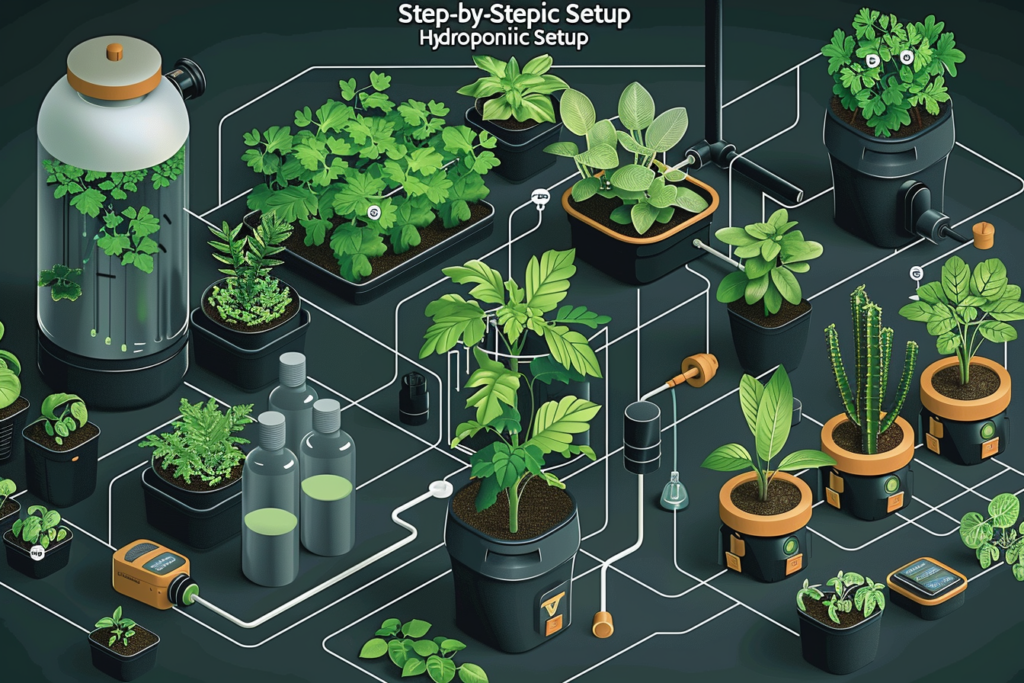
Here’s a step-by-step guide to ensure a successful setup:
1. Choose the appropriate system:
Based on your space, budget, and preferences, select a hydroponic system that suits your needs, such as ebb and flow, deep water culture, or nutrient film technique.
2. Assemble the components:
Gather all the necessary components, including the reservoir, grow trays or channels, pump, air stones, air pump, and tubing. Follow the manufacturer’s instructions for proper assembly.
3. Install the grow lights:
Determine the optimal light spectrum and intensity for brazilwood growth, and install the grow lights accordingly. LED or high-intensity discharge (HID) lamps are commonly used.
4. Set up the reservoir:
Position the reservoir in a suitable location, ensuring it’s level and easily accessible for maintenance. Fill it with clean water and add the appropriate nutrient solution according to the manufacturer’s recommendations.
5. Connect the plumbing:
Attach the tubing to the pump and distribute it to the grow trays or channels, ensuring a secure and leak-free connection.
6. Install the air stones:
Place the air stones in the reservoir and connect them to the air pump. This will provide essential oxygenation to the nutrient solution and plant roots.
7. Test the system:
Before introducing the brazilwood plants, run the system for a few days to ensure proper water circulation, aeration, and nutrient distribution.
8. Adjust pH and EC levels:
Use a reliable pH and EC meter to monitor and adjust the nutrient solution’s pH and electrical conductivity (EC) levels to the optimal range for brazilwood growth.
9. Introduce the plants:
Once the system is stable and the nutrient solution is balanced, carefully transplant the brazilwood seedlings or cuttings into the grow trays or channels.
10. Monitor and maintain:
Regularly check the system for any issues, such as clogs, leaks, or nutrient imbalances. Adjust the nutrient solution as needed and perform routine maintenance tasks like cleaning and replacing components when necessary.
Remember, setting up a hydroponic system requires patience and attention to detail. It’s essential to follow the manufacturer’s instructions and consult with experienced growers or hydroponic experts if you encounter any challenges or have specific questions regarding your brazilwood cultivation setup.
Step 3: Optimize Growing Conditions
Optimizing the growing conditions is crucial for successful brazilwood hydroponic cultivation.
I meticulously monitor and maintain the ideal water parameters, including pH, temperature, and nutrient levels, to create an environment that promotes vigorous growth. Providing the appropriate lighting spectrum and intensity is also essential, as brazilwood plants have specific light requirements for optimal photosynthesis and development.
Additionally, I ensure proper air circulation and humidity levels within the growing area, as these factors play a vital role in preventing issues like mold, pests, and diseases. By carefully optimizing these conditions, I can maximize the potential of my brazilwood plants and achieve a bountiful harvest.
Ideal water parameters (pH, temperature, nutrient levels)
Maintaining ideal water parameters is crucial for the successful hydroponic cultivation of brazilwood.
The pH level of the nutrient solution plays a pivotal role in determining the availability and absorption of essential nutrients by the plant roots.
For brazilwood, the optimal pH range is between 5.5 and 6.5, ensuring that vital nutrients like nitrogen, phosphorus, and potassium are readily accessible. Temperature is another critical factor that influences plant growth and nutrient uptake.
Brazilwood thrives in a temperature range of 68°F to 82°F (20°C to 28°C).
Maintaining the nutrient solution within this range promotes healthy root development and overall plant vigor. Nutrient levels must also be carefully monitored and adjusted to meet the specific requirements of brazilwood plants. A balanced nutrient solution should contain the appropriate ratios of macronutrients (nitrogen, phosphorus, potassium) and micronutrients (iron, calcium, magnesium, etc.).
Deficiencies or excesses can lead to stunted growth, discoloration, or other issues. Regular testing and adjustments are necessary to ensure the water parameters remain within the ideal range. Using high-quality pH and EC (electrical conductivity) meters can help accurately measure and maintain these critical factors.
Additionally, periodically flushing and replenishing the nutrient solution can help prevent the buildup of salts or other contaminants that could adversely affect plant health.
Lighting requirements for brazilwood plants
Brazilwood plants have specific lighting requirements that must be met for optimal growth and development in a hydroponic setup. These plants thrive under bright, full-spectrum light conditions, mimicking their natural environment in the Brazilian rainforests.
High-intensity discharge (HID) lamps, such as metal halide or high-pressure sodium lights, are often recommended for providing the necessary light intensity and spectrum. Alternatively, LED grow lights can also be an excellent choice, as they offer energy efficiency and customizable light spectra tailored to the plant’s needs.
Typically, a combination of blue and red wavelengths is ideal for promoting healthy vegetative growth and flowering in brazilwood plants. It’s essential to provide adequate light exposure, typically between 12 to 16 hours per day, depending on the plant’s growth stage. Proper light distribution and positioning of the lamps are also crucial to ensure even coverage and prevent issues like stretching or uneven growth.
Maintaining proper air circulation and humidity
Maintaining proper air circulation and humidity levels is vital for the successful hydroponic cultivation of brazilwood plants. Adequate air movement within the growing area helps prevent stagnant air pockets, which can lead to mold growth, pest infestations, and disease development. I ensure that my hydroponic setup incorporates fans or air circulation systems to promote a consistent flow of fresh air around the plants.
Humidity levels also play a crucial role in brazilwood’s growth and overall health. These plants thrive in a moderately humid environment, typically between 50% and 70% relative humidity. Low humidity can cause stress and stunted growth, while excessive humidity can create an ideal breeding ground for fungal diseases and pests. I carefully monitor and adjust the humidity levels using humidifiers or dehumidifiers as needed, creating an optimal microclimate for my brazilwood plants to flourish.
Step 4: Care and Maintenance
Proper care and maintenance are essential for ensuring the long-term success of brazilwood hydroponic cultivation. I diligently monitor and adjust nutrient levels, ensuring a balanced supply of essential elements for optimal plant growth. Regular pruning and training techniques are employed to promote bushier growth and maximize yields.
Additionally, I remain vigilant for any signs of pests or diseases, promptly addressing any issues through safe and effective methods. By dedicating time and effort to these crucial care and maintenance tasks, I can cultivate thriving brazilwood plants and enjoy a bountiful harvest while minimizing potential setbacks or problems.
Monitoring and adjusting nutrient levels
Monitoring and adjusting nutrient levels is a critical aspect of successful brazilwood hydroponic cultivation. I regularly test the nutrient solution using specialized meters to measure pH and electrical conductivity (EC), which indicates the concentration of dissolved nutrients. Maintaining the optimal pH range of 5.5 to 6.5 ensures that brazilwood plants can effectively absorb essential nutrients from the solution.
Additionally, I closely monitor the EC levels to ensure the nutrient concentrations are within the recommended range for brazilwood. Deficiencies or excesses can lead to stunted growth, discoloration, or other issues. Based on the test results, I carefully adjust the nutrient solution by adding or diluting the appropriate nutrient formulations, ensuring a balanced supply of macronutrients and micronutrients for optimal plant health and vigor.
Pruning and training techniques for optimal growth
Employing proper pruning and training techniques is essential for achieving optimal growth and yields in brazilwood hydroponic cultivation. Regular pruning helps promote bushier, more compact growth and encourages the development of new shoots and branches.
I carefully remove any dead, damaged, or overcrowded stems and leaves, allowing for better air circulation and light penetration throughout the plant. Topping, or cutting off the main stem’s growing tip, is a common training technique that encourages lateral branching and a fuller, more balanced plant structure. This method is particularly useful for brazilwood, as it can help maximize the number of harvestable branches and enhance overall yields. Another effective technique is low-stress training (LST), which involves gently bending and securing the stems and branches to create an even canopy and distribute growth evenly.
This method can be achieved using soft plant ties or specialized LST equipment, ensuring that the plant’s structure remains open and well-ventilated. Additionally, I may employ techniques like defoliation, which involves selectively removing larger fan leaves to improve light penetration and air flow to the lower branches and buds.
This practice can be particularly beneficial during the flowering or fruiting stages of brazilwood’s growth cycle. By consistently implementing these pruning and training techniques, I can optimize the growth patterns and yields of my brazilwood plants, while also promoting overall plant health and vigor within the hydroponic system.
Identifying and addressing common pests and diseases
Identifying and addressing common pests and diseases is crucial for maintaining the health and productivity of brazilwood plants in a hydroponic system. While hydroponic cultivation can reduce the risk of soil-borne pests and diseases, vigilance is still required to detect and address any potential issues promptly.
One common pest that can affect brazilwood plants is spider mites. These tiny arachnids can cause yellowing, stippling, and webbing on the leaves, ultimately leading to defoliation and stunted growth.
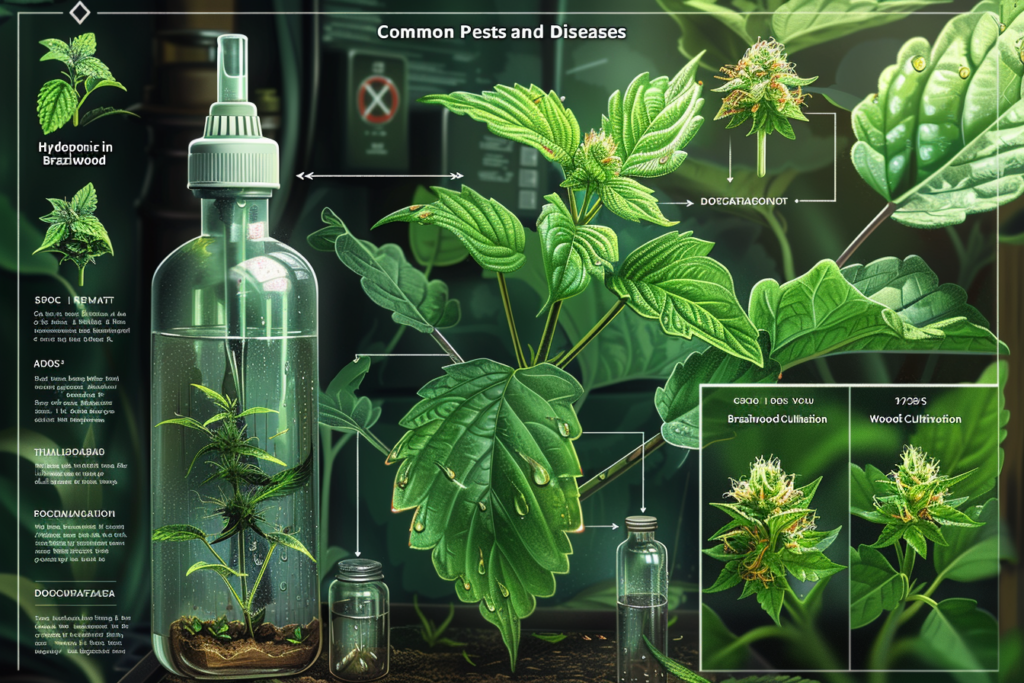
Regular inspections and the use of predatory mites or insecticidal soaps can help control spider mite infestations. Fungal diseases like powdery mildew and botrytis can also pose a threat to brazilwood plants, especially in humid environments. Powdery mildew appears as a white, powdery coating on leaves and stems, while botrytis causes gray or brown fuzzy patches. Maintaining proper air circulation, controlling humidity levels, and using fungicidal treatments can help prevent and manage these diseases. Root rot is another potential issue in hydroponic systems, often caused by overwatering, poor drainage, or contaminated nutrient solutions.
Symptoms include stunted growth, wilting, and discolored or mushy roots. Addressing the underlying cause, such as adjusting water levels or replacing the nutrient solution, is crucial for preventing further damage. Bacterial infections like erwinia and pseudomonas can also affect brazilwood plants, leading to stem rot, leaf spots, and wilting. Maintaining good hygiene practices, using sterilized equipment, and applying appropriate bactericides can help control these diseases.
Early detection and prompt action are key to addressing pests and diseases effectively. Regular inspections, quarantining affected plants, and implementing integrated pest management strategies can help minimize the impact on your brazilwood hydroponic cultivation.
Step 5: Harvesting and Post-Harvest Care
Proper harvesting and post-harvest care are crucial steps in ensuring the quality and longevity of your brazilwood hydroponic plants. I carefully monitor the plants for signs of maturity, such as color changes or specific growth patterns, to determine the optimal harvesting time. Employing gentle and precise harvesting techniques helps preserve the integrity of the plants and their valuable components.
After harvesting, I follow meticulous drying and storage methods to maintain the potency and vibrancy of the brazilwood for various applications, whether it’s for natural dyes, woodworking, or medicinal purposes. By paying close attention to these final steps, I can maximize the rewards of my hydroponic cultivation efforts.
Signs of maturity and optimal harvesting time
Determining the optimal harvesting time for brazilwood plants is crucial to ensure maximum quality and yield. One of the primary signs of maturity is a change in the color of the heartwood, which transitions from a pale yellow to a deep, vibrant red hue. This color transformation indicates the presence of brazilin, the compound responsible for brazilwood’s prized natural dye properties.
Additionally, I closely monitor the growth patterns and overall vigor of the plants. Mature brazilwood plants may exhibit slower growth rates and a more woody, sturdy stem structure. The leaves may also take on a slightly darker green color as the plant reaches its full maturity.
Consulting with experienced growers or referring to specific variety guidelines can provide valuable insights into the expected timeframe for harvesting.
Generally, brazilwood plants cultivated hydroponically may reach maturity faster than those grown in traditional soil-based methods, allowing for more efficient production cycles.
Proper harvesting techniques
Employing proper harvesting techniques is essential to ensure the quality and longevity of brazilwood plants cultivated hydroponically. I carefully time the harvest to coincide with the plant’s maturity, as indicated by the deep red color of the heartwood and the overall vigor of the plant.
During the harvesting process, I take great care to handle the plants gently, avoiding any unnecessary damage or bruising. Sharp, sterilized pruning shears or knives are used to make clean cuts, minimizing the risk of disease or pest introduction.
For larger brazilwood plants, I may opt for a gradual harvesting approach, selectively removing mature branches or stems over time. This method allows the plant to continue growing and producing new harvestable material, maximizing the overall yield. Immediately after harvesting, I take steps to preserve the quality of the brazilwood. This may involve carefully bundling the stems or branches and storing them in a cool, dry place until further processing or drying can occur.
Proper labeling and record-keeping are also crucial during the harvesting process. I document the harvest date, variety, and any relevant notes or observations to ensure traceability and consistency in future cultivation cycles.
By following these meticulous harvesting techniques, I can ensure that the valuable brazilwood plants are handled with care, maximizing their potential for use in various applications, such as natural dye production, woodworking, or medicinal purposes.
Drying and storing brazilwood for various applications
Proper drying and storage techniques are essential for preserving the quality and longevity of harvested brazilwood for various applications. Depending on the intended use, different drying methods may be employed to achieve the desired results.
For natural dye production, the brazilwood logs or branches are typically air-dried in a well-ventilated area, protected from direct sunlight. This slow drying process helps to concentrate the brazilin content, resulting in a deeper, more vibrant red hue.
Once fully dried, the wood can be chipped or ground into a powder for use in dyeing textiles, cosmetics, or other applications. If the brazilwood is intended for woodworking or decorative purposes, a kiln-drying process may be preferred.

This controlled drying method helps to prevent warping, cracking, or other deformities that can occur during air-drying. The kiln-dried wood can then be carefully stored in a cool, dry place, away from direct sunlight and moisture, to maintain its structural integrity and color vibrancy. For medicinal applications, the drying process may involve dehydrating the leaves, bark, or roots of the brazilwood plant.
This can be achieved through air-drying or using specialized dehydrators, depending on the desired end product. Once dried, the plant material can be stored in airtight containers, protected from light and moisture, to preserve its therapeutic properties. Regardless of the intended application, proper storage is crucial to maintain the quality of the dried brazilwood.
Airtight containers or bags, kept in a cool, dry, and dark environment, can help prevent moisture absorption, mold growth, and color degradation. Regular inspections and rotation of stored materials can also help ensure long-term viability and consistent quality.
Conclusion
In conclusion, cultivating brazilwood hydroponically is a rewarding endeavor that requires dedication and attention to detail. By following the five essential steps outlined – selecting the right variety, setting up the hydroponic system, optimizing growing conditions, providing proper care and maintenance, and employing careful harvesting and post-harvest techniques – you can unlock the full potential of these vibrant and versatile plants.
Embrace the journey of hydroponic gardening, and don’t hesitate to experiment and explore new methods to further enhance your brazilwood cultivation experience. With patience and perseverance, you can reap the rewards of a bountiful harvest and contribute to the growing popularity of this remarkable plant.
Recap of the 5 steps for successful brazilwood hydroponic cultivation
To cultivate brazilwood successfully in a hydroponic system, it is essential to follow these five crucial steps:
1. Choose the Right Variety:
Select a brazilwood variety that suits your needs, considering factors like growth rate, color intensity, and hardiness.
2. Set Up Your Hydroponic System:
Carefully choose and assemble the appropriate hydroponic system, ensuring all essential components are in place for optimal growth.
3. Optimize Growing Conditions:
Maintain ideal water parameters, lighting, air circulation, and humidity levels to create the perfect environment for your brazilwood plants to thrive.
4. Care and Maintenance:
Regularly monitor and adjust nutrient levels, prune and train the plants for optimal growth, and promptly address any pests or diseases that may arise.
5. Harvesting and Post-Harvest Care:
Identify the signs of maturity, employ gentle harvesting techniques, and follow proper drying and storage methods to preserve the quality of your brazilwood for various applications.
By diligently adhering to these steps, you can unlock the full potential of hydroponic brazilwood cultivation, ensuring a bountiful and rewarding harvest while contributing to the growing popularity of this remarkable plant.
Encouragement to explore and experiment with hydroponic gardening
As you embark on the journey of hydroponic brazilwood cultivation, embrace the spirit of exploration and experimentation.
Hydroponic gardening offers a world of possibilities, allowing you to push the boundaries and discover new techniques tailored to your unique setup and goals.
Don’t be afraid to try different hydroponic systems, nutrient formulations, or training methods to find what works best for your brazilwood plants. Experiment with various lighting spectra or environmental conditions to optimize growth and yield. Collaborate with fellow enthusiasts, share your experiences, and learn from their insights.
Remember, every gardener’s path is unique, and the joy lies in the journey itself. Embrace the challenges as opportunities for growth, and celebrate each success, no matter how small.
With an open mind and a willingness to learn, you can unlock the full potential of hydroponic gardening and contribute to the ever-evolving world of sustainable and innovative cultivation practices.
So, dive in, get your hands dirty (metaphorically, of course), and let your passion for brazilwood and hydroponic gardening guide you towards new heights of horticultural excellence.

